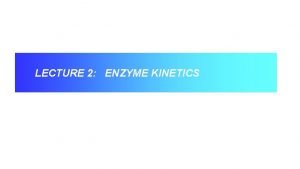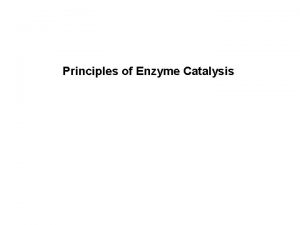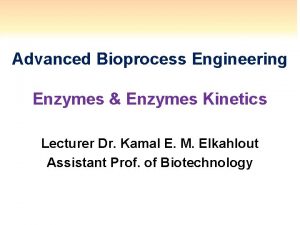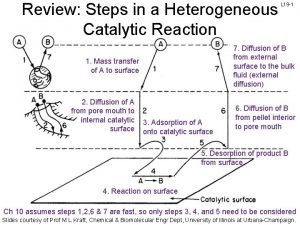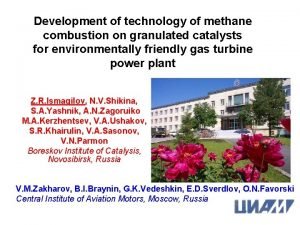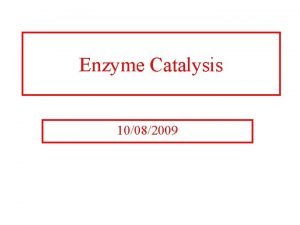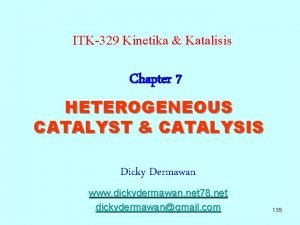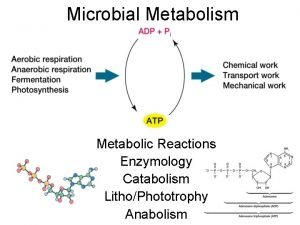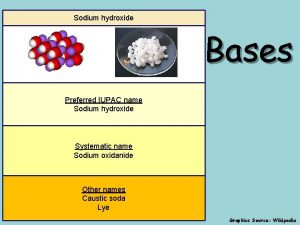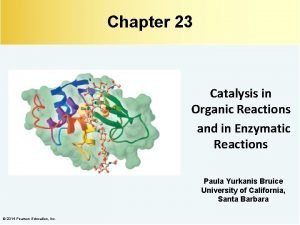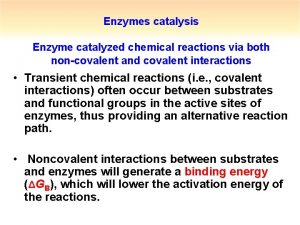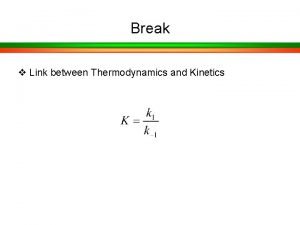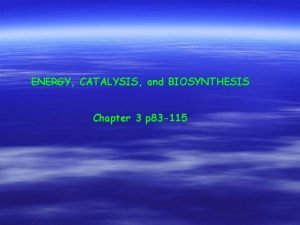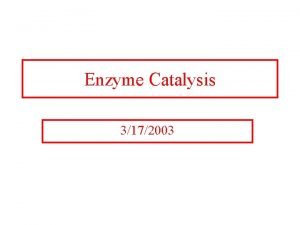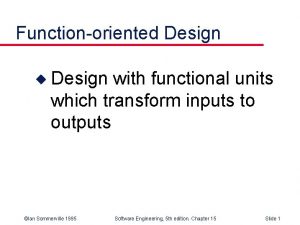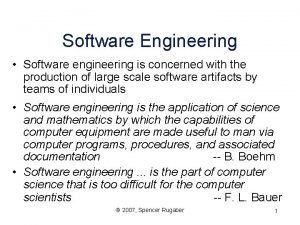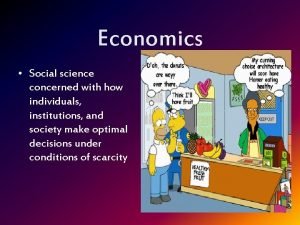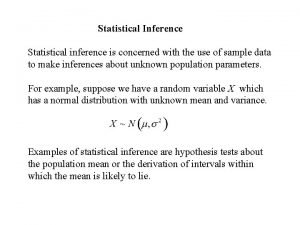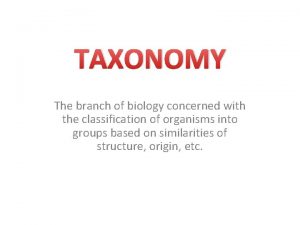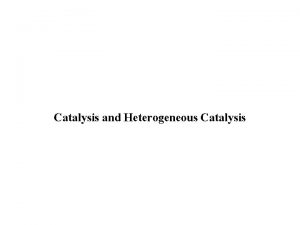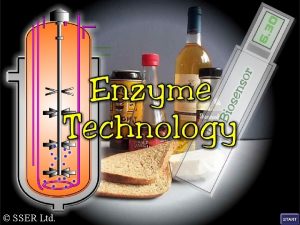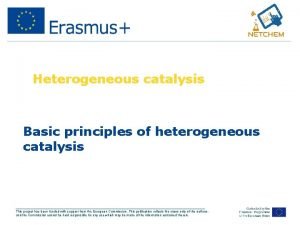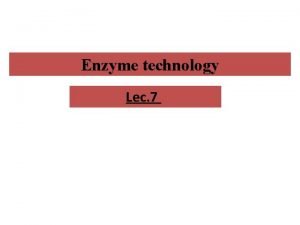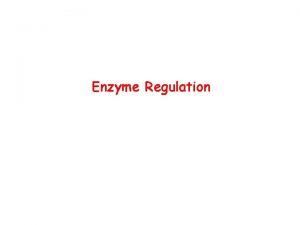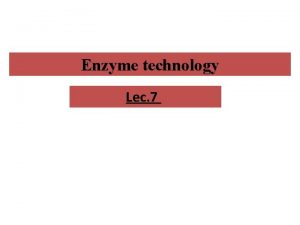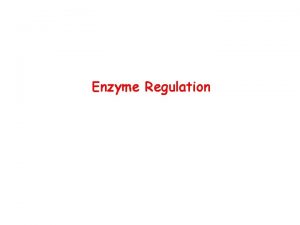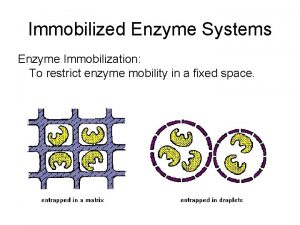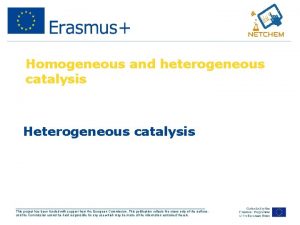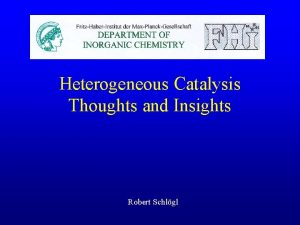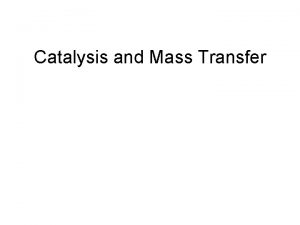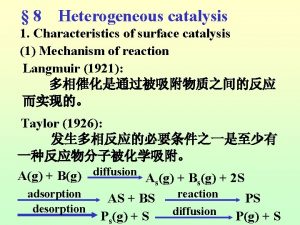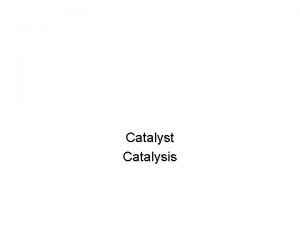Principles of Enzyme Catalysis Thermodynamics is concerned with






















- Slides: 22

Principles of Enzyme Catalysis

Thermodynamics is concerned with only the initial and final states of a process, being independent of the path(s) between the two states. Kinetics is concerned with the rate at which the process occurs and thus is concerned with the path(s) between the two states. The parable of the sugar packet

Time Scale for Selected Biochemically Important Reactions Carbonic anhydrase kcat = 20 x 106 s-1 Wolfenden, R. (2003) Thermodynamic and extrathermodynamic requirements of enzyme catalysis. Biophys. Chem. 105, 559 -572.


Collision Theory Number of molecules Boltzmann distribution DG‡ Kinetic energy k = (gk. BT/h) C 1 -n e-DG‡/RT is inversely proportional to the height of the barrier (DG‡) but proportional to temperature is proportional to the concentration of reactants is proportional to the probability of a productive collision The rate constant for the reaction

Encounter Complex In this encounter complex there is a greater probability that the reactants will collide rather than diffuse apart. As two reactants diffuse together they become caged by the surrounding water molecules.

DG‡ = DH‡ -TDS‡ DG = DH -TDS

Potential Mechanisms for Enzyme Catalytic Efficiency • By binding substrates in the active site, enzymes can increase the effective local concentrations of reactants (Proximity effects) • Substrate binding can correctly orient reacting groups in the active site (Orbital steering) • Enzymes can promote desolvation upon substrate binding • Enzymes can enhance the inherent reactivity of functional groups by altering the microenvironment within the active site

Entropy-Enthalpy Compensation The unfavorable entropy of activation (DS‡) of bringing the reactants together into the encounter complex is compensated by the favorable enthalpy of binding (DH) of the reactants in the active site. By binding substrates in the active site, enzymes can produce effective concentrations orders of magnitude greater than can be achieved in the absence of the catalyst.

Proximity Effects

Induced Fit (Transition State Binding) Wolfenden, R. (2003) Biophys. Chem. 105, 559 -572

Induced Fit (Transition State Binding) Methotrexate Aminopterin

Microenvironment Effects Mechanism of Acetoacetate Decarboxylase

Ho et al. (2009) Nature 459, 393 -397

Ramped N-terminus to C-terminus Lys 115 Substrate Schiff base Arg 29 Ho et al. (2009) Nature 459, 393 -397

General Acid-Base Catalysis Human Pancreatic Ribonuclease His 219 C N His 112

General Acid-Base Catalysis Mechanism of Ribonuclease

Induced Fit in the Mechanism of Lysozyme E 35 D 52 C C Rings A-D

Vocadlo et al. (2001) Nature 412, 835 -838

Covalent Catalysis in the Serine Proteases Asp 102 His 57 Ser 195


Trypsin Chymotrypsin Thrombin Subtilisin
 Km in enzyme kinetics
Km in enzyme kinetics Thermodynamics is concerned with
Thermodynamics is concerned with Specific acid base catalysis
Specific acid base catalysis 7 steps of heterogeneous catalysis
7 steps of heterogeneous catalysis Site:slidetodoc.com
Site:slidetodoc.com What is covalent catalysis
What is covalent catalysis Langmuir-hinshelwood mechanism heterogeneous catalysis
Langmuir-hinshelwood mechanism heterogeneous catalysis Metabolism
Metabolism Honh2 dissociation equation
Honh2 dissociation equation Specific acid base catalysis
Specific acid base catalysis Catalysis lecture notes
Catalysis lecture notes Catalysis by approximation
Catalysis by approximation Specific acid base catalysis
Specific acid base catalysis Energy catalysis and biosynthesis
Energy catalysis and biosynthesis What is covalent catalysis
What is covalent catalysis Scope of mathematics
Scope of mathematics Biology is concerned with
Biology is concerned with Structural decomposition is concerned with function calls.
Structural decomposition is concerned with function calls. Spencer rugaber
Spencer rugaber The social science concerned with how individuals
The social science concerned with how individuals Statistical inference is concerned with
Statistical inference is concerned with Dogs belong to the order felidae.
Dogs belong to the order felidae. Science is concerned with
Science is concerned with
